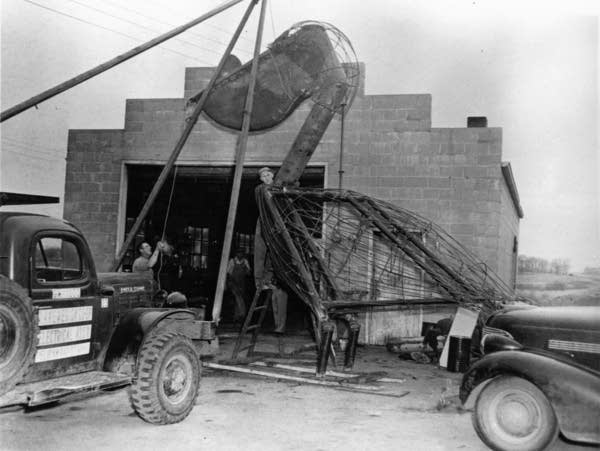‘Pelican Pete’ takes a trip to make way for dam removal

Go Deeper.
Create an account or log in to save stories.
Like this?
Thanks for liking this story! We have added it to a list of your favorite stories.
A familiar icon has stood guard in the west-central Minnesota city of Pelican Rapids — and been the subject of countless vacation photos and selfies — for more than 65 years.
But last week, a crane hoisted “Pelican Pete,” a 15-foot pelican statue made of concrete and steel, to a temporary perch a few blocks away. Pete was moved to clear the way for removal of an aging dam that will be replaced with rock rapids.
Dubbed the “world’s largest pelican,” the sculpture has stood next to the Pelican River in the city’s downtown since 1957.
City Administrator Lance Roisum said Pelican Pete will return to a new location when the project is complete.
Turn Up Your Support
MPR News helps you turn down the noise and build shared understanding. Turn up your support for this public resource and keep trusted journalism accessible to all.
“He’s in need of some repair, so we’re going to get some repairs done before he gets put back in the spring or summer at some point,” Roisum said.

The $2.72 million Pelican Rapids project is one of several locations where the Minnesota Department of Natural Resources is removing aging and sometimes failing dams, rather than spending money on costly repairs.
Many of the state’s dams were built more than a century ago to control lake levels or generate hydropower. But a dam’s average life span is about 50 years, and some are posing safety risks.
In their place, the DNR is constructing rock arch rapids, a series of boulders that allow the river to flow more naturally and fish to swim upstream for spawning.
The rapids also will offer recreational opportunities for kayakers, canoeists and tubers, and flat stones along the riverbank will provide a place to fish.
Roisum said Pelican Pete’s removal generated a lot of attention, and many people turned out to watch him being transported by crane.
“It’s tough, because he’s been there for so long — longer than I’ve been alive,” he said. “We don’t always like change, but he kind of had to be moved for this project. And I think in the end, it’s going to be a very good thing.”
The project will include installing walking paths that will provide the public with easy access to the statue, Roisum said. The city also received a state grant to build a walking bridge above the rapids.
“You'd be amazed at how many people have taken a picture by Pelican Pete through the years, and that shouldn't change at all,” he said.

Without the DNR stepping in, the city would have been on the hook financially to replace the aging dam.
Still, Roisum acknowledged that the change is hard for some people. The cascading water over the dam has been a fixture for many years, and “it’s hard to see it go,” he said.
“But on the other hand, when this is all done, I think people will really, really enjoy what the final product is,” Rosium said.


